We’ve so far collected 2022 GCSE data from over 1,000 state-funded secondary schools covering 174,000 pupils, roughly a third of the national cohort.
The data used in this blogpost is from our 2022 GCSE Early Results Service. As well as providing a full national analysis of your school’s GCSE results, this year’s reports include attendance data collected via Attendance Tracker. This means that schools can assess the impact of absence on students’ results
FFT schools wanting an early GCSE analysis before the start of term can log in to FFT Aspire and upload their results. The first closing date for this service is 5pm on Friday 26 August with reports available on 2 September. The final closing date is 9 September with reports available on 16 September.
In this blogpost we present some very rough analysis of this data.
The disadvantage gap may not have increased much (if at all) since 2019
As we showed in our preview post on Wednesday, absence rates for disadvantaged pupils have been far higher than for other pupils since the pandemic started.
We feared that the gap in disadvantaged pupils and their peers would increase as a result.
This was despite concerns about the comparability of data about disadvantage since changes were made to eligibility criteria in 2018.
However, early results suggest that the gap may not have widened much, if at all.
We compare data from 2022 with that from 2019 for schools that have supplied us with data in 2022. We use published 2019 data for this. 22% of the cohort in 2022 were classified as disadvantaged (eligible for free school meals in the previous 6 years) compared to 25% in 2019, slightly lower than the national average that year of 27%.
Data from these schools suggests a very, very slight increase in the attainment gaps in both English and maths since 2019.
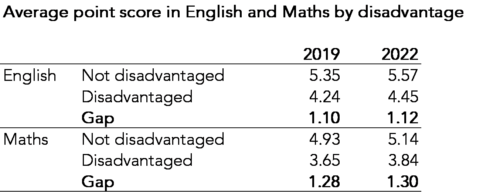
The Department for Education will publish its gap index in the Autumn. During the pandemic, the disadvantage gap fell between 2019 and 2020 before increasing in 2021.
Whether we see the index remaining above 2019 levels we will see.
Despite lower results nationally, some schools’ results have increased compared to 2021
In a speech given in June 2022, the Chief Regulator at Ofqual said that “schools that get higher results than in 2021 will be few and far between, if any.”
Very similar words appeared in an Ofqual blog the following month.
Almost 800 of the schools we collected data from in 2022 had also done so in 2021.
In maths at least, nearly a third (33%) recorded an improvement in results.

Perhaps Ofqual meant an increase in results overall.
But even then, it looks like over quarter of schools increased the percentage of entries (in all subjects) graded 9-7 compared to last year.
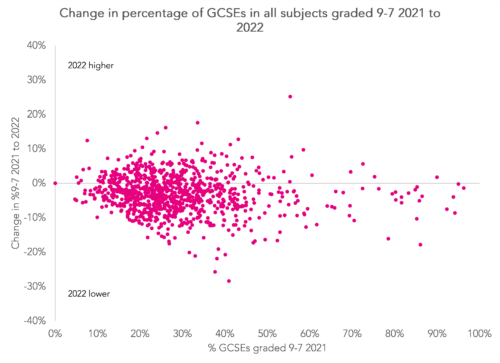
Compared to 2019, schools with the lowest rates of Year 11 absence in 2022 tended to improve their results by a greater margin
We’ve also been collecting attendance data since the pandemic started (see here for example).
We calculate the absence rate for Year 11 pupils in 2022 at each school and divide them into five equally sized ranked bands based on this measure.
For each of the five bands we calculate the average point score (APS) in maths in 2019 and in 2022. This data is summarised in the following table.
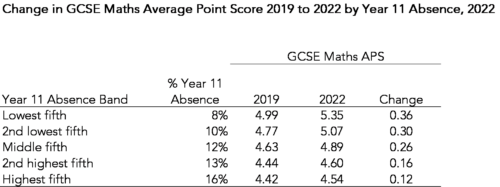
The APS in maths increased on average by 0.36 in schools with the lowest rates of Year 11 absence compared to 0.12 points among schools with the highest rates. The schools with the lowest rates already tended to have been higher attaining in 2019.
As always, the picture for individual schools is more complicated. In the chart below, we compare the change in GCSE maths APS between 2019 and 2022 among schools in the lowest fifth and highest fifth of schools for Year 11 absence.
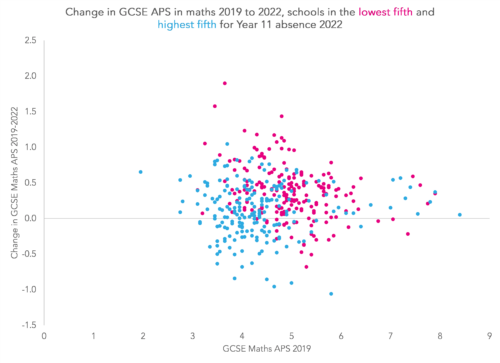
This shows that there are schools with high rates of Year 11 absence in 2022 which nonetheless improved attainment in maths compared to 2019 by similar (or even higher) margins than schools with lower rates of absence.
Obviously, there may be much more going on beneath the surface, such as changes in the composition of the pupil intake at individual schools. But that’s a story for another day.





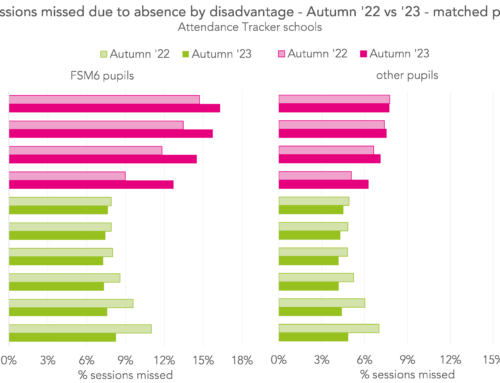
Am a bit confused by your commentary on EBacc? Gov figures are
Subject grouping Summer 2018 Summer 2019 Summer 2020 Summer 2021 Summer 2022
EBacc entries 4,054,475 4,206,700 4,297,100 4,337,685 4,378,110
Non-EBacc entries 1,082,020 979,150 984,645 963,390 971,140
Percent EBacc entries 78.9% 81.1% 81.4% 81.8% 81.8%
Percent non-EBacc entries 21.1% 18.9% 18.6% 18.2% 18.2%
So EBacc very much growing rather than shrinking?
Hi Reza. Understandable! So starting with the figures we’ve put out today, they show the % of pupils in state-funded schools entered for all 5 pillars of the EBacc- so English, maths, 2 sciences, a humanity and a modern or ancient language. The figures you’ve quoted are from Ofqual’s provisional summer entries. They show the total number of entries in all EBacc subjects (so adding together entries in English, maths, sciences etc.). This does show an increase an entries, but the population has also been increasing. In addition, the data are provisional. Some pupils subsequently aren’t entered (e.g. in Spanish the entries reported by JCQ yesterday were 8% lower than reported by Ofqual). The Ofqual data also includes students of all ages in all types of centre, whereas EBacc only applies to end of Key Stage 4 pupils in state-funded schools.
Hi there. Great article. My query relates to the last 10ish years, not specifically to recent developments. Are you aware of any comparisons of the “disadvantage gap” between GCSE Maths and GCSE English, as per your very useful tabulation of 2019 and 2022 data? My own conversations with local teachers, as well as theoretical “cultural capital” considerations, suggest that the disadvantage gap might tend to be bigger for English than for Maths (“you don’t need culture-at-home to do well in maths, just effective teaching”). But that hypothesis doesn’t appear to be supported by your 2019/2022 data tabulation. If you can direct me to any relevant data or analysis, that’d be really appreciated!
Hi Guy. Interesting question- thank you. Certainly for 2022 it appears the gap is slightly narrower in English than in maths although I’d probably want to do some more detailed analysis to be sure. I can’t immediately think of anything that has looked at English and maths separately (most analysis of gaps combines the two). Could be one for us to look at.
Thanks so much Dave, response really appreciated. Would be great if you could look into this, of course; but equally, I’ll keep digging myself. The question first arose from a conversation with the head of a school that was in a bad place 10 years ago, but is now doing very well: he indicated great GCSE results in maths and science, but English and humanities more challenging. Of course it might be just a one-off, not indicative of any general pattern. I guess one statistical approach would be to try to pull out schools with relatively disadvantaged intake and recent overall-performance improvement, then within that subset see if any English/Maths difference. Anyway, will keep looking. Thank you!!! – Guy